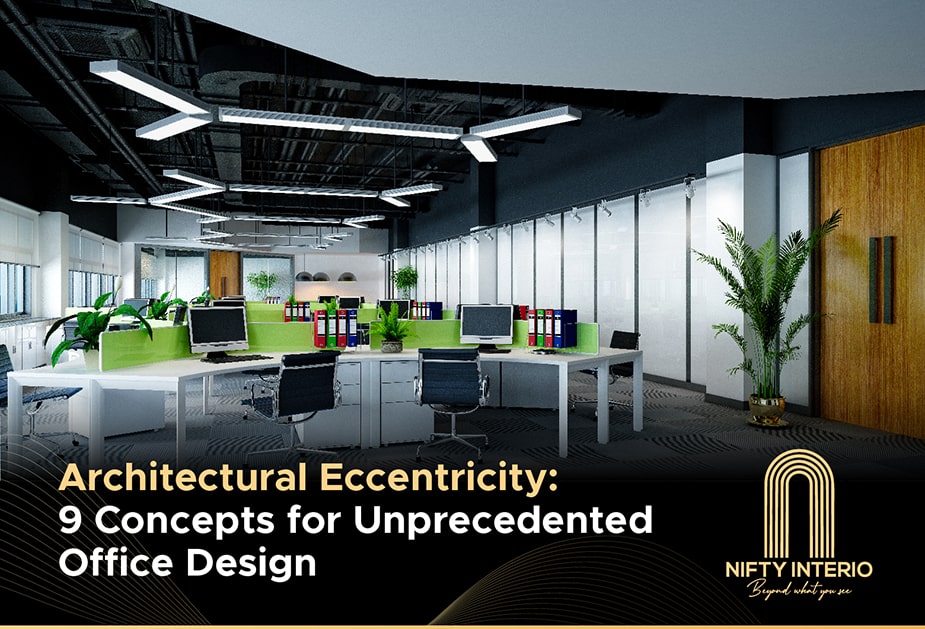Architectural Eccentricity: 9 Concepts for Unprecedented Office Design

May 17, 2024
Collaboration is at the heart of modern workplace culture, driving innovation and productivity. In Hyderabad, known for its vibrant tech scene and rapid urban development, commercial interior designers are redefining the concept of collaborative spaces in office interiors. This blog explores how commercial interior designers in Hyderabad are creating environments that foster teamwork, creativity, and communication, offering insights into the latest trends and best practices in office interior design.

1. The Rise of Open Concept Workspaces
Open-concept workspaces have become a staple in modern office design. This approach removes barriers and creates fluid, adaptable environments where employees can easily interact. Commercial interior designers are embracing this trend, creating open areas that encourage spontaneous collaboration and cross-departmental communication.
These open spaces often include communal tables, lounge areas, and flexible seating arrangements. The goal is to break down silos and promote a sense of community within the workplace. While open concepts are not without challenges—such as noise and lack of privacy—designers are addressing these issues through innovative acoustic solutions and private breakout spaces.
2. Creating Multi-Functional Collaboration Zones
Commercial interior designers recognise that collaboration takes many forms. To accommodate different types of teamwork, they are designing multi-functional collaboration zones. These areas can be used for team meetings, brainstorming sessions, or informal discussions, offering versatility to suit various needs.
Key elements of multi-functional collaboration zones include modular furniture, writable surfaces, and technology integration. These spaces often feature movable whiteboards, digital screens for presentations, and charging stations for electronic devices. By providing flexibility and functionality, designers are enabling teams to work together more effectively.
3. Incorporating Technology for Seamless Collaboration
Technology plays a crucial role in facilitating collaboration. In Hyderabad’s tech-savvy environment, commercial interior designers are integrating advanced technology into collaborative spaces. This includes high-quality video conferencing equipment, smart boards, and collaborative software tools.
The seamless integration of technology allows teams to collaborate both in-person and remotely, reflecting the growing trend of hybrid work models. Meeting rooms are equipped with video conferencing capabilities, enabling teams to connect with colleagues and clients worldwide. Additionally, designers are using smart technology to enhance productivity, such as automated booking systems for meeting rooms and IoT-enabled devices for real-time communication.
4. Designing for Flexibility and Adaptability
In a fast-paced business environment, office spaces must be flexible and adaptable. Commercial interior designers are creating spaces that can easily transform to meet changing demands. This flexibility is achieved through modular furniture, movable partitions, and adaptable layouts.
Flexibility in office design allows companies to reconfigure spaces as needed, whether for large team meetings or smaller group discussions. This adaptability also supports a dynamic work culture, where employees can move freely and collaborate with different teams. By designing for flexibility, commercial interior designers are empowering companies to stay agile and responsive to evolving business needs.
5. Fostering a Culture of Innovation
Innovation thrives in environments that encourage creativity and experimentation. Commercial interior designers create spaces that inspire employees to think outside the box. This involves incorporating unique design elements, such as bold colours, art installations, and unconventional furniture.
Spaces designed for innovation often feature brainstorming rooms with writable walls, creative zones with interactive displays, and comfortable lounge areas for informal discussions. By fostering a culture of innovation, designers are helping companies attract and retain top talent, as employees are drawn to workplaces that encourage creativity and personal growth.

6. Embracing Biophilic Design for Collaborative Spaces
Biophilic design, which connects people with nature, has been shown to boost creativity and reduce stress. Commercial interior designers are embracing biophilic elements in collaborative spaces to create a calming and inspiring atmosphere. This includes incorporating plants, natural light, and organic materials.
Collaborative spaces with biophilic design often feature indoor gardens, large windows, and natural wood accents. These elements create a sense of tranquillity, encouraging employees to relax and engage in meaningful conversations. By embracing biophilic design, commercial interior designers are enhancing the quality of collaborative spaces and promoting employee well-being.
7. Creating Spaces for Social Interaction and Team Building
Collaboration goes beyond work-related discussions; it also involves social interaction and team building. Commercial interior designers are creating spaces that encourage employees to connect on a personal level. These spaces include communal kitchens, game rooms, and outdoor terraces.
Social interaction spaces serve as hubs for team-building activities and company events. They provide opportunities for employees to unwind, share ideas, and build relationships. By creating spaces for social interaction, designers are contributing to a positive workplace culture and strengthening team cohesion.
8. Reflecting Brand Identity in Collaborative Spaces
An office’s interior design should reflect a company’s brand identity and values. Commercial interior designers ensure that collaborative spaces align with a company’s unique brand. This includes using brand colours, logos, and design elements that reflect the company’s mission and vision.
Brand identity in collaborative spaces helps employees feel connected to the company’s purpose and fosters a sense of pride. It also creates a consistent visual experience for visitors and clients, reinforcing the company’s image. By reflecting brand identity, designers are helping companies establish a strong workplace culture that resonates with employees and stakeholders.
9. Designing for Inclusivity and Accessibility
Inclusivity and accessibility are essential in collaborative spaces. Commercial interior designers are ensuring that these spaces are designed for all employees, regardless of physical abilities or backgrounds. This includes providing wheelchair access, adjustable furniture, and gender-neutral facilities.
Inclusive collaborative spaces promote diversity and ensure that everyone can participate in teamwork and collaboration. Designers are also considering cultural inclusivity, creating spaces that respect different customs and traditions. By designing for inclusivity and accessibility, commercial interior designers are promoting a workplace culture that values diversity and equal opportunities.
Also read:Eccentric Elegance: 12 Infusions of Unique Design Elements in Your Office
These nine trends demonstrate how commercial interior designers in Hyderabad are revolutionising office interior designs by crafting collaborative spaces that inspire creativity, foster teamwork, and promote inclusivity. From open-concept workspaces to technology integration, these innovative designs are shaping the future of work, creating environments where employees can thrive and companies can succeed. By embracing flexibility, biophilic design, and a focus on brand identity, designers are contributing to a vibrant and dynamic workplace culture.

An ambitious entrepreneur & self-made designer revolutionizing interior aesthetics with innovative, functional, & personalized designs. Founder of Nifty Interio, creating designs that bring dreams to life.
